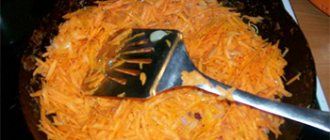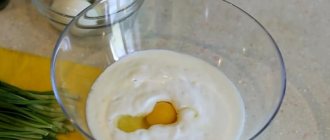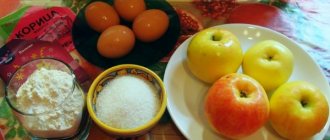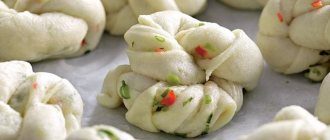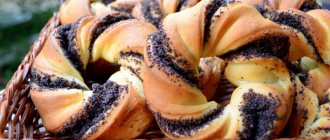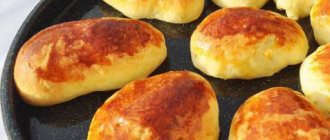Every housewife should try making pianse pies according to a recipe with a photo. Many will appreciate this pastry, as it is steamed. Everyone loves fried pies, but they are often afraid of the possible consequences. This is especially true for mothers who worry about their children.
Korean pianse recipe with photos
Ingredients
Wheat flour 3 cups. Garlic 2 cloves Granulated sugar 1 tsp.
- Number of servings: 5
- Cooking time: 45 minutes
Pyanse in Korean: composition
Delicate Korean pies stuffed with minced meat and cabbage are very tasty, despite the fact that they are steamed. The calorie content of pyanse is 185 kcal per 100 g. List of necessary products:
- wheat flour (3.5 tbsp.);
- water (250 ml);
- dessert spoon of yeast;
- cabbage (350 g);
- meat (300 g);
- 2 large onions;
- a couple of cloves of garlic;
- sunflower oil (35 ml);
- granulated sugar (1 tsp);
- salt pepper.
Any meat can be used. But the filling made from two types of meat is especially tasty. The dough is kneaded in water; no baking is needed.
What is pyan se (pyanse)
Pian se are Asian pies filled with minced meat and cabbage, which makes them high in calories. The convenience of consuming this dish led to its spread as fast food. Essentially, these are the same pies, but with a few differences in the recipe. Their photos can be found below.
Depending on the region of preparation and the recipe, it can be found under the following names:
On the territory of the Russian Federation, it can be found in regions located close to the borders of countries such as China, Mongolia and Kazakhstan. It is sold in the same way as hot dogs, burgers and other foods.
In some regions, the recipe may be prepared differently. The most popular recipe is pyanse with Korean carrots and kimchi.
There is still debate about which recipe for pian se is original and fundamental. If we look at it from an official point of view, we can say that classic pyanse are prepared only in Vladivostok; a patent for this dish was even officially registered there.
How to steam pianse?
So, how to make pyanse at home?
- First you need to do the test.
- Stir the specified amount of yeast in lukewarm water and add granulated sugar.
- Wait a bit for the yeast to rise.
- Mix flour, water, salt and yeast thoroughly and knead the dough, periodically lubricating your hands with vegetable oil.
Cover the finished dough with a towel and place in a warm place to rise.
Meanwhile, prepare the meat and cabbage:
- Grind the meat through a meat grinder.
- Peel the onion and garlic and chop finely.
- Chop the white cabbage thinly, add a little salt and mash it with your hands so that it is not hard and tough.
- Combine cabbage, minced meat, onion and garlic and mix.
- Add pepper and salt generously, not skimping, as the filling should have a spicy taste.
- When the dough has risen, form it into balls and flatten them. Place the filling compactly on each layer.
- Pinch the edges well so that there are no unpleasant surprises during the cooking process.
Place the finished Korean-style pyanse on a greased steamer sheet at a decent distance from each other. Steaming time is ¾ hours, and the lid must not be opened. The countdown starts from the moment of boiling.
Serve the finished products with spicy Korean salads. In the original, each pie is cut into two parts and a spoonful of salad is placed inside. It turns out tasty and healthy. Knowing how to cook steamed pyanse, you can bake such pies at least every day without fear for the health of your household.
Pyanse or pyan-se are savory yeast pies stuffed with cabbage and minced meat, steamed. Korea is considered the birthplace of delicious pianse. There is even a mention of a similar dish in the royal menu, which has been written down for more than 700 years.
It is believed that the dish got its name because of its excellent taste, since pyanse is translated from Korean as “highest grade”. The pies are also known as pian-tse, pyeongsu, pygodi, wangmandu, baozi and mantou. In Russia, pyanse is widespread as street fast food; it is sold in places selling hot dogs and other foods.
Juicy, aromatic pies may differ slightly in taste, since in different regions they are prepared and served in their own way - in some places it is customary to add kimchu or Korean carrots to the prepared ones, and in others it is believed that they are eaten only as a snack with first courses.
Moreover, every resident of one or another region where this hearty and juicy delicacy is so popular claims that their pyanse are the real ones. But of course, the most famous pyanse are sold in Vladivostok - it was there that a patent was received for production according to a certain recipe.
I’ll give you our homemade recipe, which I got from my grandmother, a little later, but for now I want to share the secrets of delicious pyanse.
- The dough for these pies may be different, but one thing remains the same - it is made with yeast. Sometimes there are options where soda is also added to the yeast - the combination of soda and yeast is quite common in Asian cuisine.
- The composition may differ in the quantity and ratio of ingredients - there are options with sour milk, water, the usual wheat flour, as well as rice, buckwheat, with the addition of starch, etc.
- Whether it will be a sponge or non-pair method will also depend on what is more familiar to you. But in any case, the composition should include eggs, vegetable oil, salt and a little sugar (solely as a nutrient medium for yeast).
- The consistency of the dough should be soft, not sticky to your hands, pliable and tender. Now there are a few options.
Tips from housewives
In order to prepare the dish correctly, you need to follow several recommendations, such as:
Delicious recipe! Recipe for baking chicken in the oven
Pianse dough with sour milk using sponge method
First we will make the dough, and only then we will knead the dough itself.
Ingredients:
- warm water - 0.5 tbsp
- sugar - 1 tbsp.
- live yeast - 2 tbsp.
- sour milk (kefir, yogurt) - 400 ml
- vegetable oil - 120-150 ml
- salt - 0.5 tsp.
- flour - how much dough will take
Preparation:
The dough rests for 20-30 minutes (until a head of yeast foam forms). Then the remaining components are added and the dough is kneaded to the desired consistency. And then, as usual, cover, set aside, knead 1-2 times when it increases in volume.
Option on water with soda
This recipe is prepared without milk using the straight method. Many people believe that this is the real dough for pyanse in Korean. If you have a good food processor, I recommend kneading in it. A bread maker will also work.
Ingredients:
- water - 200 ml
- dry yeast - 1-1.5 tsp.
- salt - 0.5 tsp.
- sugar - 1 tbsp.
- vegetable oil - 2 tbsp.
- flour - 450-550 g
- corn starch - 3-4 tbsp.
- soda - 1/3 tsp.
Preparation:
- Pour dry yeast into warm water, stir - it should dissolve. Then we simply mix all the products in a food processor or by hand, monitoring the consistency of the dough - if necessary, add a little flour. Cover with film and let rise 1-2 times.
- There is no consensus on how to sculpt a pianse. The shape of steamed Asian pies can be either round, like manti and Georgian khinkali, or oblong, like pirozhki or Ukrainian dumplings.
Pianse. What's inside?
At first glance, the filling of these pies is the same - minced meat with cabbage. It’s just that there are a lot of subtleties here. True connoisseurs do not recognize any vegetarian variations or minced meat without cabbage.
The meat should be 50/50 pork and beef.
- raw minced meat and raw cabbage;
- fried meat and raw vegetable component;
- stewed cabbage and meat without any thermal preparation.
In our family, pyanse, the recipe with a photo below, is prepared exclusively with sauerkraut.
Toppings for pianse
Essentially, all recipes combine two main ingredients: meat and cabbage. But thanks to the addition of spices and vegetables, you can create a whole palette of different tastes at home.
To create an original minced meat recipe, just mix two equal parts of pork and beef. It is advisable to take fatty parts of animals, this allows you to prepare juicy pyanse.
- Unprocessed meat and cabbage.
- The same thing only fried.
- Stewed or simmered.
Any meat can be used, but traditionally, minced pork and beef are added to pyansa.
How to cook pian se?
But here there are no more disputes - steam the pies for 40-50 minutes, always covering them with a lid so that the dough turns out fluffy and airy.
The modern housewife has a huge choice of devices suitable for this purpose - from a double boiler to a mantyshnitsa. You can also cook pianse in a slow cooker if you have a special steaming device.
The molded pies should either be placed on a surface greased with vegetable oil, or the bottom should be dipped into the oil and only then sent to cook.
Homemade pianse recipe
In our family, this dish was made long before pian-se began to be sold on every corner. And there is no talk at all about the difference in taste between pyanse prepared at home and sold from a tray!
Step 1: prepare the flour.
Using a sieve, sift the flour directly into a medium bowl so that there are no flour lumps in the dough, and it turns out more airy and soft due to impregnation with oxygen from the air.
Step 2: Prepare the yeast mixture.
Pour purified water into a small saucepan and place the container on low heat. In literally 4-6 minutes
the water will become warm, and this is exactly what we need to knead the dough.
Attention:
if the water reaches a temperature above
36°-38°C
, simply set the pan aside and give it time to cool slightly.
So, after that, turn off the burner, add sugar to warm water and mix everything well with a tablespoon.
After this, pour the dry yeast into the container, and again, carefully stirring everything with available equipment, dissolve the component in the liquid and then set it aside to brew for 10 minutes.
Important: if the water temperature is higher than required, then the yeast may deteriorate and the pies simply will not turn out.
Step 3: prepare the dough.
So, pour the infused yeast mixture into a deep bowl and add a pinch of salt there and, using a tablespoon, carefully add flour in small portions. Knead the dough for 7-10 minutes
until it becomes dense and no longer sticks to your hands.
Attention:
you can knead the dough with a tablespoon, with a blender, or with your hands.
In a word, whatever is more convenient for you. The main thing is that the dough turns out without flour lumps and has the correct consistency. At the end, add vegetable oil to the dough and knead the dough again. Afterwards, we form the dough into a ball and place it in a bowl, also pre-greased on all sides with vegetable oil. This must be done so that the dough does not weather and does not stick to the bottom and walls of the container. So, now wrap the bowl with the dough in cling film and set it aside in a warm place to rest for 1 hour.
During this period of time, the dough should
double in size.
In the meantime, let’s prepare the filling for pyan-se.
Step 4: prepare the cabbage.
First of all, remove the top coarsened leaves from the cabbage and then rinse the ingredient well under running water. Place the vegetable on a cutting board and, using a knife, chop the cabbage. Transfer the chopped component into a free deep bowl, add salt to taste and knead it a little with your hands so that the cabbage releases a small amount of juice.
Step 5: prepare the onion.
Using a knife, peel the onion and then rinse the ingredient well under running warm water. Place the vegetable on a cutting board and, using the same sharp utensils at hand, chop the onion into small squares, no larger than 5 millimeters
. Transfer the finely chopped onion to a clean medium bowl.
Step 6: prepare the garlic.
Using a knife, peel the garlic and then lightly rinse the ingredient under running water. Then, place the garlic cloves on a cutting board and, using the same sharp tools at hand, finely chop the component. Afterwards, transfer the garlic into a bowl with the chopped onion.
Step 7: prepare the minced meat.
Place the minced pork and beef in a bowl with chopped onion and garlic, add ground black pepper to taste and, using a tablespoon, thoroughly mix all the ingredients until a homogeneous mass is formed. Attention:
if you are using freshly frozen minced meat, then it must be removed from the freezer in advance and set aside to cool to room temperature. Under no circumstances should the meat component be defrosted in a microwave oven or under running hot water, as this may spoil the taste of the filling.
Step 8: prepare the pian-se filling.
Place shredded cabbage in a frying pan and place the container over medium heat. After the frying pan is well heated and the cabbage at the bottom of the container begins to “sizzle,” cover the frying pan tightly with a lid and simmer the cabbage filling for 10 minutes,
removing the lid from time to time and stirring everything with a tablespoon.
Attention:
there is no need to add vegetable oil, since the cabbage should be stewed in its own juice. After the allotted time has passed, turn off the burner, remove the lid from the pan and set the cabbage aside to cool slightly.
Now add the minced meat to the pan and mix everything well with a tablespoon until smooth. That's it, the filling is ready.
Step 8: prepare pian-se.
After the allotted time for infusion of the dough has passed, knead it well again so that the carbon dioxide formed due to yeast fermentation is released from the test ingredient. Place the dough on the kitchen table, dusted with a little flour, and use a knife to cut the dough piece into small pieces. Attention:
the pieces must be the same size as the size you want to form the pies.
After this, we form a ball from each piece with our hands.
Using a rolling pin, roll each ball into a flat cake approximately 8-10 millimeters
. Using a teaspoon, place the filling in the center of each flatbread.
And now we begin to form the pian-se. The shape of these pies can be whatever suits your taste. You can make an oval pie by pinching the edges of the dough tightly with your fingers in the center of the dish, while you need to somehow gather the seam, making it more grooved and beautiful, and without crushing it. Or, for example, you can make a round pyang-se. To do this, you need to gather the edges of the dough, just like tying a bag into a knot. In this case, it is necessary to bend the edges of the cake one by one towards the center, pressing the dough well with your fingers so that during the cooking process our pie does not open up and the filling does not fall into the steamer container.
As soon as all the pies are formed, place the pies in portions into a steamer or pressure cooker and cook them for
40 minutes.
After the allotted time has passed, use a slotted spoon or fork to remove the pies from the container and transfer them to a serving dish.
Step 9: Serve pian-se.
While still hot after cooking, it is best to serve them immediately. But you can treat guests to such pies along with sour cream, mayonnaise or any sauce of your choice.
Pyan-se turn out to be very tasty, aromatic and with a juicy, filling filling.
Enjoy your meal! — — If you want to cook pian-se during Lent, then minced meat can be replaced with fried mushrooms.
— — In addition to spices such as ground black pepper, you can add a little ground red pepper to the filling. But this is only if you like spicy dishes.
— — Instead of white cabbage, you can shred Chinese cabbage into the filling. Then the pyan-se turn out even more tender and fragrant.
— — If you don’t have a special steamer or pressure cooker at hand, don’t worry, because you can always buy a fan steamer. These utensils are very convenient and easy to use. To do this, you need to fill a regular deep frying pan or cauldron with thick walls and bottom with a small amount of water, place a fan steamer in the container and place the pies on its surface. To prevent the dish from sticking to the surface of the steamer, you can grease it with a small amount of vegetable oil using a pastry brush. After this, put the container on less than medium heat, cover the frying pan or cauldron tightly with a lid and cook pyan-se for the allotted time.
Pigodi – steamed pies with minced meat
Korean pies with steamed meat and cabbage, also called pian-sho
,
pegezy
or
pygodi
, I tried it as a child in Yuzhno-Sakhalinsk. The impression they made was so strong that even after many years I still remembered the taste, the composition of the filling and the surprisingly white color of the pian-se (then I could not understand: if the pian-se is a pie, then why is it not ruddy, but white like a dumpling?!).
And recently I decided to look for how pian-sho is prepared. It turned out that the recipe for steamed pies is simple both in composition and in the method of preparation. Especially in our age of electric steamers. The long-awaited Korean pies turned out very tasty, especially if eaten with spicy sauce.
What is pigodi (pian-sho) made from?
for 20 pies
Yeast dough
- Flour – 800 g + 100 g for sprinkling;
- Warm water – (2 glasses);
- Sugar – 1 teaspoon;
- Salt – 1 teaspoon;
- Dry yeast – 1 teaspoon.
Filling of Korean pies
- Minced meat (preferably pork and beef) or finely chopped meat – 300 g;
- White cabbage (you can take Chinese salad = Chinese cabbage) – 300 g;
- Onion – 1 head;
- Garlic – 2 cloves;
- Greens (dill, parsley, cilantro or basil) - to taste;
- Ground coriander – 0.5 teaspoon;
- Ground black pepper – 0.5 teaspoon;
- Salt - to taste.
Vegetable oil for lubricating the steamer - a little.
Composition of sauce for pigodi (pyan-sho, pegez)
- Soy sauce – 1/4 cup;
- Table vinegar 9% – 1 tablespoon;
- Sugar – 1 tablespoon;
- Ground black pepper – 0.5 teaspoon;
- Garlic – 2 cloves;
- Cilantro or other greens - several sprigs;
- Chili pepper (red bitter) - a little;
- Salt - to taste, optional, soy sauce is salty).
Recipe for "Pyan-tse":
Let's start with the test. Sift the flour into a bowl, add yeast, salt, soda and water.
Knead a not very stiff, elastic dough that does not stick to your hands. It is not forbidden to add flour during the process, since the properties of flour are different for everyone. Cover with a towel or film. We're sending him over.
Now for the filling. Cut the onion into half rings and fry until transparent
Add the minced meat and fry, not forgetting to break up the lumps
While the minced meat is frying, we have time to chop the cabbage and cut the kim chi
The minced meat is fried, add the cabbage and mix
When the cabbage has fried a little, add kim chi and mix again. And in general, do not forget to stir periodically)))
Our filling is almost up to standard)) Squeeze the garlic, salt and pepper to taste. Let it simmer a little and that’s it, the filling is ready. ATTENTION! If you don’t have kim-chi, then skip the previous step and add red hot pepper to the filling to taste, and black pepper too.
Delicious recipe! Delicious dinner for my husband using simple ingredients
Our dough came out well
Place it on the work surface and form a nice sausage. Cut into portions
Add a generous portion of filling
We make transverse tucks.
Here they are, our beauties! But in general, you can pinch it however you like. I pinch the classic puffins with a “pigtail”, like dumplings, but I can’t do that, no matter how much I was taught ( ( Let it sit for about 20 minutes under a towel.
Prepare the steamer. Pour water and grease the bowls with vegetable oil. PySy: lubricate the bowls before each filling, otherwise you will tear all the bottoms
When laying the pian-tse, we leave enough space between them; in the process they will increase greatly. Cook for 15-20 minutes. If you roll out the dough thinly, then 15 minutes is enough, but if it’s thicker, then 20. But no more! Otherwise they will fall off and be slimy, like overcooked dumplings
Our babies are ready)))
Remove to a plate greased with vegetable oil and let rest a little before putting into a common bowl (while the next batch is being prepared). If you wish, you can grease each with vegetable oil or melted butter.
Subscribe to the Povarenka group on VKontakte and receive ten new recipes every day!
Join our group on Odnoklassniki and receive new recipes every day!
Share the recipe with friends:
| Do you like our recipes? |
| BB embed code: BB code is used on forums |
| HTML embed code: HTML code is used in blogs, such as LiveJournal |
How will it look like?
Other recipe options
Pyan-tse
- 62
- 647
- 23712
Similar Recipes
Pumpkin dough roll
- 25
- 159
- 9049
Pear pudding
- 12
- 52
- 4613
Honey gingerbread with steamed nuts
- 256
- 2597
- 210658
Steamed cheese rolls
- 3
- 109
- 4025
Dessert with prunes
- 27
- 51
- 3951
Steamed rolls with wood mushrooms
- 2
- 29
- 2079
Potato and cheese roll in a steamer
- 2
- 59
- 2496
Cappuccino cupcake
- 55
- 175
- 10635
Snack steamed buns
- 15
- 108
- 1611
How to cook pyan-se (pygodi, pegezy)
Prepare dough for Korean pies
- Stir yeast and sugar in 0.5 cups of warm water (30-35 degrees C).
- As soon as the yeast comes to life and foam appears, combine the yeast with the rest of the water. Add salt. Gradually add flour. Knead the dough. We will have a dough.
- Cover the bowl/pan with the dough with a lid, then with a towel (to preserve heat). And put it in a warm place (usually it’s warmest in the kitchen near the ceiling, you can put it on a cabinet). Let the dough rise (it should increase 1.5-2 times).
- Knead the risen dough and let it rise again (do this 1-2 times). The finished dough will increase in volume to at least 2 times its original size.
- Afterwards, sprinkle the table with flour, place the dough on it and knead it again (until it becomes smooth and shiny). If the dough sticks to your hands, add more flour (usually for pian-sho you use stronger dough than for regular pies).
The time required to rise the pian-sho dough depends on the type and quality of the yeast, and how favorable (warm) conditions are created in the kitchen for the dough. It takes approximately 2 hours to prepare the yeast dough for pian-sho.
Prepare the filling of pigodi (pian-sho)
- Finely chop (chop) the meat or make minced meat. You can use ready-made, purchased minced meat of good quality.
- Chop the cabbage thinly and finely. Sprinkle a little salt and squeeze with your hands (so that it softens and absorbs the salt). Usually, in winter they sell cabbage with hard and rough leaves. Then it is better to replace it with Chinese cabbage (Chinese salad).
- Finely chop the onion. Pass the garlic through a press (you can grate or chop finely). Cut off the thick stems of the greens and finely chop the leaves.
- Combine minced meat, cabbage, herbs, onions, garlic, spices. Add salt and stir well.
Make a pygodi (pian-sho)
- Form the dough into a ball, then divide into 20 parts. Which are also rolled into balls. Flatten the balls into flat cakes (less than 0.5 cm thick). This is the basis of the yang-sho pie.
- Place 1 tablespoon of minced meat on each flatbread. First connect the middle of the pie, then pick up the edges. You should get a neat sealed seam, and the pigodi should take on an oval shape with rounded or pointed ends. If desired, it can be with curly tucks (for beauty).
Cook pigodi (pyang-se) in a steamer
- Grease the steamer bowl with vegetable oil. Place the pies seam side down at a distance from each other, because the pyan-sho will increase in volume during cooking.
- Pour hot water into the lower bowl of the steamer (this way we will save time by skipping the stage of heating the water). To cover with a lid. Cook pian-sho in a double boiler for 40 minutes.
How to serve and store pian-sho (pygodi)
- Ready-made white Korean pies can be greased with vegetable or butter. This way they will shine beautifully.
- It is better to serve pian-sho with a spicy soy sauce. It will be simply delicious! Although, the pies are good on their own.
- Pian-sho (pigodi) should be stored in a sealed container or tightly tied plastic bag.
